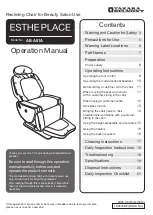
Installation Instructions
GENERAL INFORMATION
•
Read all instructions before beginning installation
•
For use on 4, 6 and 8 cylinder, even fire engines.
•
Compatible systems include 12-volt negative ground, inductive type, single coil applications.
•
Do not use with solid core spark plug wires.
•
Disconnect the battery before installation.
MOUNTING INSTRUCTIONS
1. Choose a place to mount the Second Strike box that is reasonably flat. Keep it away from direct heat, excessive
vibration and areas susceptible to wet conditions.
2. Position the Second Strike in the desired mounting position. Use the box as a template and mark the four mounting
points.
3. Choose the mounting hardware type that best suits your application. NOTE: Sheet metal screws can be used when the
back side of the mounting surface is not accessible. Machine screws should be used when both sides of the mounting
surface are accessible.
WIRING THE SECOND STRIKE
There are two types of systems which the Second Strike can be configured for. These are categorized as HEI and Non-
HEI systems. Determine which system you have and follow the corresponding wiring instructions below. Wires can be short-
ened or lengthened to the desired length. Use the proper gauge wire when lengthening and make sure all connections are
crimped tight or soldered, and insulated. Wires not used should also be insulated. Remember to reconnect the battery after
the installation is completed.
Non-HEI type systems. (FIGURE 1)
1. Attach the BLACK wire to a good engine ground or battery negative terminal. Make sure the connection is free of dirt,
grease and paint.
2. Attach the RED wire to the positive battery terminal or positive terminal of the starter solenoid.
3. Attach the GREEN wire to a 12 volt power source controlled by the ignition switch. The coil positive terminal can be
used as a power source as long as it provides a non-resisted 12 volts.
4. Attach the YELLOW wire to the coil’s negative terminal. Use provided ring terminal.
5. The WHITE wire is a tachometer output, compatible with most modern tachometers. Tachometer can be connected to
the WHITE wire or the negative (-) terminal of the coil. If the white wire is not used, make sure it is properly isolated.
WARNING!!! DO NOT CONNECT WHITE WIRE TO THE NEGATIVE (-) TERMINAL OF THE COIL.
HEI type systems. (FIGURE 2)
1. Attach the BLACK wire to a good engine ground or battery negative terminal. Make sure the connection is free of dirt,
grease and paint.
2. Attach the RED wire to positive battery terminal or positive terminal of the starter solenoid.
3. Attach the GREEN wire to a 12 volt power source controlled by the ignition switch. For GM HEI applications remove the
original ignition switch wire from the terminal marked “BAT” on the coil cover. Plug the provided adapter harness onto
this terminal and then reconnect the original ignition switch wire. Attach the GREEN wire to the open terminal on the
adapter harness.
4. Crimp the provided slip-on connector to the YELLOW wire. Attach this wire to the coil’s negative terminal. On GM HEI
applications, plug the YELLOW wire onto the terminal marked “TACH” on the coil cover. If the terminal is currently used,
remove the wire, plug the provided adapter harness onto the terminal and then reconnect the wire. Attach the YELLOW
wire to the open terminal on the adapter harness.
5. The WHITE wire is a tachometer output, compatible with most modern tachometers. Tachometer can be connected to
the WHITE wire or the negative (-) terminal of the coil. If the white wire is not used, make sure it is properly isolated.
WARNING!!! DO NOT CONNECT WHITE WIRE TO THE NEGATIVE (-) TERMINAL OF THE COIL.
#8 x 3/4 Sheet Metal Screw
Use a #31 drill bit (.120”) for
screw hole.
8-32 x 5/8 Machine Screw
Use a #29 drill bit (.136”) for
screw hole.
0018-008811
12/13
Page 1 of 4






















